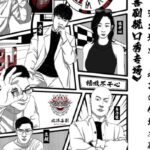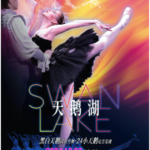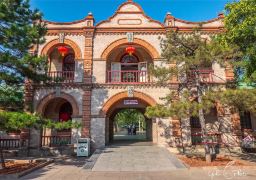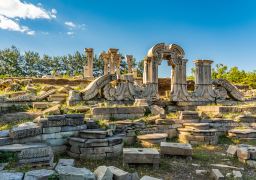The ballet ‘Dream of the Red Chamber’ is adapted from the pinnacle of Chinese classical novels, reshaping and exploring the dramatic tension, aesthetic connotations, and worldview of ‘a world with emotions’ from a contemporary perspective. In the 1980s, the veteran artists of the Central Ballet created a four-act ballet ‘Lin Daiyu’, with the fourth act ‘Death of Daiyu’ capturing the protagonist’s pursuit of love with vivid and touching techniques of space-time transition. This new creation by the troupe focuses on the love between Bao and Daiyu and the spiritual world of Baoyu, depicting the protagonists’ struggle against fate and pursuit of the eternal values of truth, beauty, and emotion in humanity.
Respecting the original work, the ballet combines psychological ballet techniques, restructures character psychology on the existing dramatic structure, and fully expresses the emotions and spirit of both the collective and individual characters. The work aims to deeply excavate the philosophical thoughts, aesthetic foundations, and spirit of the times contained in Chinese excellent traditional culture, and to create a new era of literary and artistic works that demonstrate cultural confidence, express national emotions, and interpret Chinese aesthetics and philosophical depth through the international language of ballet and the integration of Chinese and Western artistic presentation. The ballet ‘Dream of the Red Chamber’ abandons the situational reproduction and schematic expression of the original, choosing the love between Bao and Daiyu and Baoyu’s spiritual world as the main clues and structural threads, expressing the protagonists’ break through the ritual teachings, seeking the sincere expression of true feelings, and the eternal pursuit of truth, goodness, and beauty in human nature. The entire play is interwoven by symphonic group dances and personalized characters, depicting the prosperity of a large family while heavily depicting the emotional and spiritual fate of Bao and Daiyu from the germination of love to the spiritual unity. As a work that ‘mainly talks about emotions’, the ballet ‘Dream of the Red Chamber’ focuses on the profound observation of ’emotions’, fully expressing individual emotions and spirit from a contemporary perspective, and constantly tries to explore the depth and complexity of the work’s connotation, covering not only the melancholy of fleeting beauty and the sigh of fate’s impermanence but also the questioning and contemplation of the ultimate meaning of life. The ballet achieves free conversion between the protagonist’s psychological space and the real world through ingenious structural settings and innovative breakthroughs in form, creating a ‘real and illusory’ temporal and spatial experience and a combined image space: dramatic scenes that promote plot development and the depiction of others through Xiao Baoyu’s eyes outline the prosperous Jia family group; the interweaving use of solo, duet, trio, and quartet dances and the complex structure of ‘play within a play’ unfold the emotional world and psychological space of Bao and Daiyu; the ‘Twelve Beauties of Jinling’ are transformed into twelve poetic and aesthetic flower souls, foreshadowing the process from prosperity to flower burial in the Grand View Garden; and the strong contrast and contrast of Daiyu burning the manuscript highlight the heart-wrenching tragedy of Bao and Daiyu’s love and the lamentable fate.In terms of dance vocabulary, the work focuses on the refinement of thematic movements and the unified echo between language and formal structure, fully leveraging the romantic and aesthetic characteristics of ballet art. It innovatively integrates Chinese classical dance with ballet, seeking a strong sense of form and precise dance vocabulary, organically merging the beauty of form with touching emotions to convey the rich implications of the work. To complete the creation of the ballet ‘Dream of the Red Chamber’ at a high level, the Beijing Central Ballet has assembled a top-tier creative team renowned both domestically and internationally. The team is led by the troupe leader Feng Ying as the chief planner and producer, with Ye Xiaogang, the chairman of the Chinese Musicians’ Association and a professor at the Central Conservatory of Music, as the composer. Feng Li, the dean of the China National Children’s Art Theatre and a national first-class playwright, serves as the scriptwriter. Tong Rui, a director and national first-class choreographer from the China National Opera and Dance Drama Theater, is the chief director. Liu Xinglin, a professor at the Central Academy of Drama, is responsible for set design, and the outstanding costume designer Yang Donglin is in charge of costume and styling design. The renowned producer Li Dong acts as a production consultant. The production will also showcase the impressive capabilities of the Central Ballet’s outstanding young creative talents, with choreographers Zhang Zhenxin and Zheng Yu, and lighting designer Liu Zhao, injecting youthful vitality into the quality presentation of the work. The Central Ballet creative team is committed to creating classics and, while insisting on the combination of ballet’s ‘internationality’ and ‘nationality,’ they delve deeply into their work. They use ballet art to express the emotions of the Chinese nation, highlight the cultural depth of China, and strengthen cultural confidence. The creative team will uphold their reverence for ‘Dream of the Red Chamber,’ an immortal masterpiece of Chinese classical literature, and continuously explore and actively seek international expressions for ethnic ballet. They strive to make the ballet ‘Dream of the Red Chamber’ a milestone in the development of Chinese ballet, showcasing the humanistic feelings, philosophical thoughts, and aesthetic temperament with Chinese charm and Eastern philosophical connotations contained in China’s excellent traditional culture on the world stage.
Plot Introduction Prologue: In the vast wilderness, Baoyu embarks on the path of seclusion. Once the many fragrances of the Grand View Garden are transformed into flower souls, they float along like shadows. The past lives of Baoyu and Daiyu—Xiangzhu Fairy Grass and Shenying Attendant—are faintly visible, entwined and lingering… Act One, Scene One: In Baoyu’s gaze, the former glory of Rongguo Mansion is reborn, a scene of bustling prosperity. Young Baoyu is the center of attention. Young Daiyu, with the sound of oars and the moon, passes through the deep courtyard corridors. The first meeting of the two teenagers evokes their past life’s affection, faintly, by the Three Lives Stone, their bond is enduring… Act One, Scene Two: In the blue gauze room, two innocents are carefree. Everyone welcomes Baochai into the house, and the jade pendant and golden lock with the spiritual jade seem to be a perfect match.Daiyu feels lonely in her heart. Baoyu cannot please both sides. In Act One, Scene Three, Baoyu reads books by his father’s command and falls asleep out of boredom. He is surrounded by the Jia family, loved and bound by their affection. As the world turns, the wheel of fate spins. The appearance of the Empress marks the family’s glory reaching its peak. In Act One, Scene Four, Baoyu and Daiyu read ‘The Western Chamber’ together, their feelings blossoming amidst a myriad of idle sorrows… Baochai chases butterflies, and in the Grand View Garden, all the beauties vie for the spring. Baoyu plays and jokes with his sisters like a butterfly among flowers, while Daiyu, with a sense of compassion and shared fate, buries the flowers alone, pondering, ‘Today I bury the flowers, and people laugh at my folly; who will bury me when my time comes?’ In Act Two, Scene One, Baoyu gathers friends and rebels against the norms, incurring the severe punishment of his father, Jia Zheng. Upon waking, Daiyu is heartbroken. Baoyu gives her a handkerchief, and Daiyu finally understands his feelings, ‘All his deep affection is concentrated at the tip of his pen’… In Act Two, Scene Two, at night, everyone in the Yihong Courtyard celebrates Baoyu’s birthday, casting aside hierarchy and restraint, enjoying themselves to the fullest, truly like the last carnival of youth for the children of the Grand View Garden. Outside the courtyard, the Jia family is raided, and the news of the Empress’s death brings sorrow and fear. Baoyu, in his grief, laughs foolishly, having lost his jade and his soul. In Act Two, Scene Three, Xifeng devises a plan to cheer Baoyu up with a wedding. On one side, there is forced joy, and on the other, the burning of manuscripts ends all affection. As the veil is lifted, Baoyu cries out in sorrow… The curtain falls, and people disperse. In the epilogue, Baoyu walks alone in the vast wilderness, between the shadows of flowers and spirits, meeting and parting with his lifelong entanglement once again. A moment’s dream, a moment’s eternity. The performance is open from December 21st to 22nd, Saturday to Sunday. Performance times and duration are subject to the venue.









